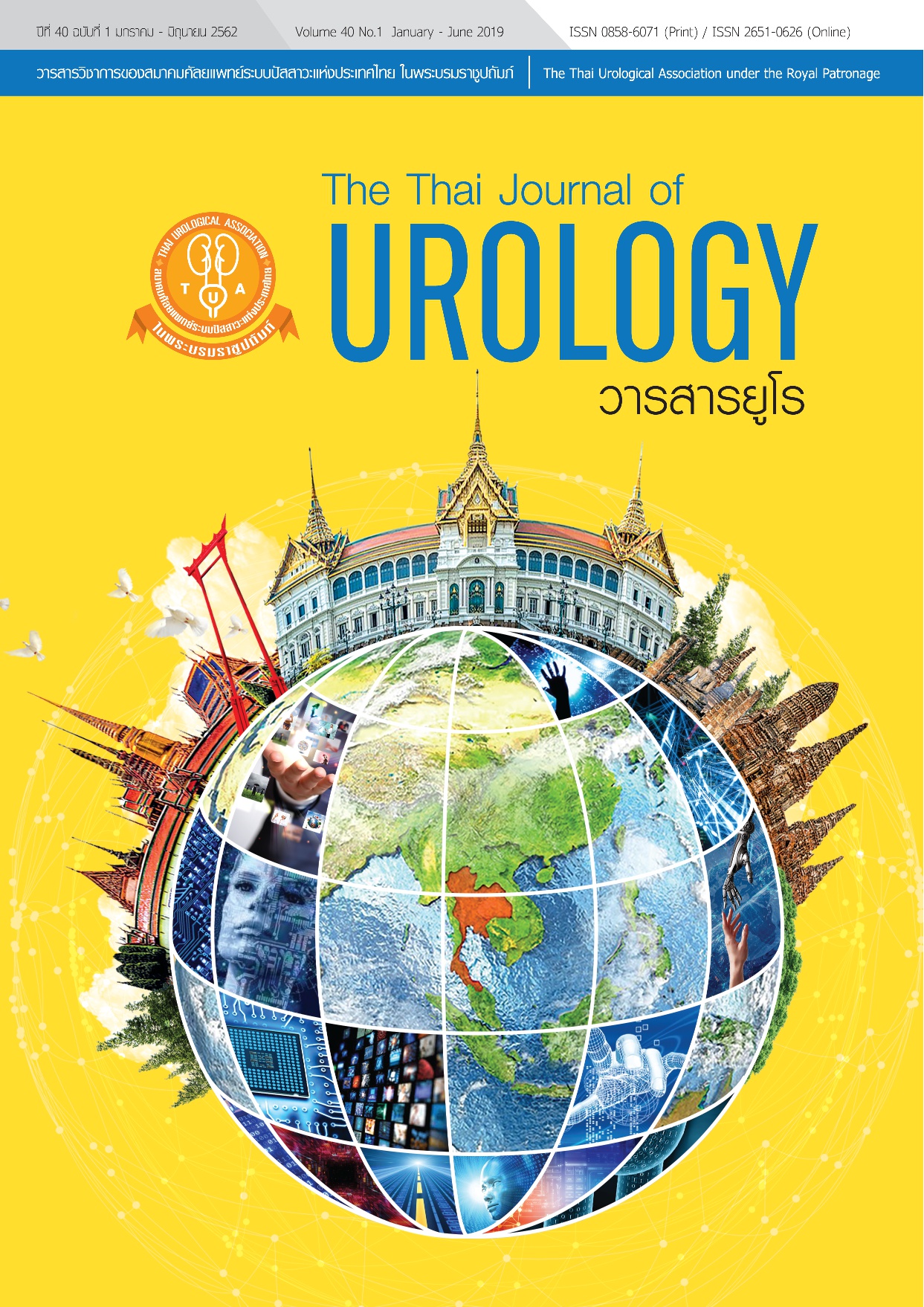Correlation between preoperative remaining kidney volume and chronic kidney disease after donor nephrectomy
Keywords:
living donor kidney transplantation, kidney volume, chronic kidney diseaseAbstract
Objective: The aim of this study was to evaluate whether preoperative remaining kidney volume correlates with renal function after a donor nephrectomy.
Material and Method: A total of 303 kidney donors who underwent donor nephrectomies at Ramathibodi Hospital in Bangkok, Thailand between January 2011 and December 2015 were retrospectively reviewed. The donors’ preoperative kidney volumes were calculated from computed tomography angiographies of the renal artery. Each donor’s demographic data, surgical approach (open/laparoscopic), donated kidney side (right/left), and post-operative renal function (creatinine level and eGFR) were collected and analyzed between the two groups.
Result: Seventy of the living kidney donors developed CKD. There were no statistical differences in the donated kidney side (p=0.371), surgical approach (p=0.549), donated kidney volume (p=0.087), donated kidney volume percentage (p=0.126), remaining kidney volume percentage (p=0.126), weight (p=0.056), height (p=0.355), and body mass index (BMI) (p=0.062) between the two groups. The donor age medians in the CKD group and non-CKD group were 48 years old [interquartile range (IQR)=42-53] and 35 years old (IQR=29-44), respectively. The mean preoperative remaining kidney volumes in the CKD group and non-CKD group, respectively, were 114.6 ml [standard deviation (SD)=16.6] and 122.2 ml (SD=21.1). There were statistically significant differences in age (p=0.000), gender (p=0.001), and preoperative remaining kidney volume (p=0.002) between the two groups. Multivariate analysis showed that gender, age, BMI, and remaining kidney volume exhibited significant odds ratios (OR=8.971, 1.109, 1.167, and 0.973, respectively); therefore, all of these variables were predictive risk factors for the development of CKD after a donor nephrectomy at the 1-year follow-up.
Conclusion: Preoperative remaining kidney volume, age, gender, and BMI were found to be correlated with CKD after a donor nephrectomy at the 1-year follow-up.
References
2. Terasaki PI, Cecka JM, Gjertson DW, Takemoto S. High survival rates of kidney transplants from spousal and living unrelated donors. New England Journal of Medicine. 1995;333(6):333-6.
3. Ingsathit A, Thakkinstian A, Chaiprasert A, Sangthawan P, Gojaseni P, Kiattisunthorn K, et al. Prevalence and risk factors of chronic kidney disease in the Thai adult population: Thai SEEK study. Nephrology Dialysis Transplantation. 2010;25(5):1567-75.
4. Noppakun K, Ingsathit A, Pongskul C, Premasthian N, Avihingsanon Y, Lumpaopong A, et al. A 25-year experience of kidney transplantation in Thailand: report from the Thai Transplant Registry. Nephrology. 2015;20(3):177-83.
5. Wu FM, Tay MH, Tai BC, Chen Z, Tan L, Goh BY, et al. Preoperative renal volume: a surrogate measure for radical nephrectomy-induced chronic kidney disease. Journal of Endourology. 2015;29(12):1406-11.
6. Levey AS, Stevens LA, Schmid CH, Zhang YL, Castro AF, 3rd, Feldman HI, et al. A new equation to estimate glomerular filtration rate. Annals of Internal Medicine. 2009;150(9):604-12.
7. Yakoubi R, Autorino R, Kassab A, Long JA, Haber GP, Kaouk JH. Does preserved kidney volume predict 1 year donor renal function after laparoscopic living donor nephrectomy? International Journal of Urology: Official Journal of the Japanese Urological Association. 2013;20(9):931-4.
8. Rook M, Bosma RJ, van Son WJ, Hofker HS, van der Heide JJ, ter Wee PM, et al. Nephrectomy elicits impact of age and BMI on renal hemodynamics: lower postdonation reserve capacity in older or overweight kidney donors. American Journal of Transplantation: Official Journal of the American Society of Transplantation and the American Society of Transplant Surgeons. 2008;8(10):2077-85.
9. Barlow AD, Taylor AH, Elwell R, Buttress AS, Moorhouse J, Nicholson ML. The performance of three estimates of glomerular filtration rate before and after live donor nephrectomy. Transplant International: Official Journal of the European Society for Organ Transplantation. 2010;23(4):417-23.
10. Burballa C, Crespo M, Redondo-Pachón D, Pérez-Sáez MJ, Mir M, Arias-Cabrales C, et al. MDRD or CKD-EPI for glomerular filtration rate estimation in living kidney donors. Nefrología (English Edition). 2018;38(2):207-12.
11. Gardan E, Jacquemont L, Perret C, Heudes PM, Gourraud PA, Hourmant M, et al. Renal cortical volume: High correlation with pre- and post-operative renal function in living kidney donors. European Journal of Radiology. 2018;99:118-23.


